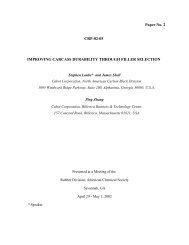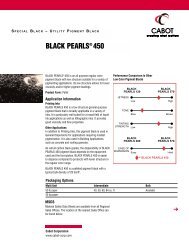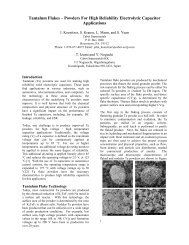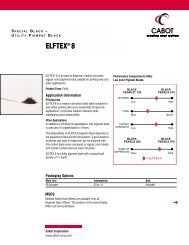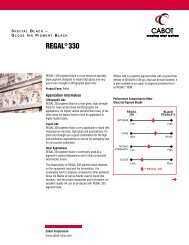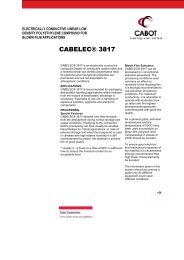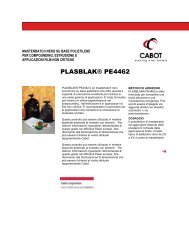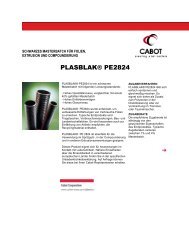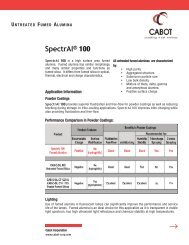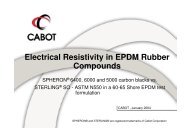Melt Flow Index - Cabot Corporation
Melt Flow Index - Cabot Corporation
Melt Flow Index - Cabot Corporation
Create successful ePaper yourself
Turn your PDF publications into a flip-book with our unique Google optimized e-Paper software.
How does someone choose a masterbatch for a specific<br />
use ?<br />
The ideal choice of a masterbatch for a specific end use is one that<br />
matches the MFI of the masterbatch as closely as possible with the<br />
MFI of the base resin.<br />
This is reasonably easy to do with titanium dioxide-based (white)<br />
masterbatches and some additive masterbatches, but not as simple<br />
with black masterbatch because of the reinforcing nature described<br />
above.<br />
If the masterbatch is to be compounded into the base polymer<br />
using, for example, high shear mixing equipment, an internal mixer<br />
or twin screw extruder, it is possible to choose a fairly low MFI<br />
carrier resin and still achieve excellent incorporation. Polymer<br />
producers generally follow this practice when making pipe or cable<br />
compounds in order not to affect the final performance properties<br />
of the compound.<br />
If poor distribution occurs when simultaneously feeding masterbatch<br />
and resin into an injection moulding or extrusion process where<br />
the shear forces are somewhat lower, the processor can adjust<br />
equipment operation conditions (such as increased back pressure,<br />
use of turbine mixing heads, or cavity transfer mixers at the end of<br />
the extruder screw). To maintain output rates, usually the processor<br />
specifies a masterbatch that is compatible with the base resin and<br />
the operating conditions.<br />
If necessary, adjustments to increase the MFI of black masterbatches<br />
are possible.<br />
Three suggestions are to use:<br />
• a higher flow carrier resin;<br />
• a less reinforcing grade of carbon black; or<br />
• process aids (e.g. stearates).<br />
If none of these are acceptable, then reducing the carbon black<br />
content in the masterbatch may be the only answer (for example<br />
use a 25% or 30% masterbatch instead of a 40% or 50%).<br />
When combinations of masterbatches are used, the high flow<br />
nature of one can adversely affect the proper incorporation of the<br />
other. In the manufacture of tackified silage film, for instance, some<br />
manufacturers add a PIB masterbatch (PIB = polyisobutylene) and<br />
black masterbatch simultaneoulsy. If distribution problems occur<br />
because the PIB reduces the shear in the system, the black<br />
masterbatch must be respecified.<br />
4



